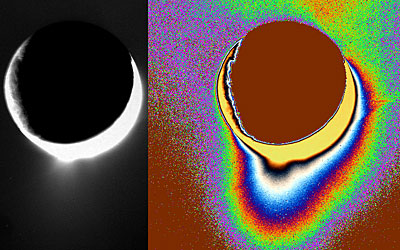
NASA's Cassini spacecraft may have found evidence of liquid water reservoirs that erupt in geysers on Saturn's moon Enceladus. The rare occurrence of liquid water so near the surface raises many new questions about the mysterious moon.
"We realize that this is a radical conclusion -- that we may have evidence for liquid water within a body so small and so cold," said Cassini imaging team leader Carolyn Porco. "If we are right, we have significantly broadened the diversity of solar system environments where we might possibly have conditions suitable for living organisms."
High-resolution Cassini images show icy jets and towering plumes ejecting large quantities of particles at high speed. Scientists examined several models to explain the process. They ruled out the idea the particles are produced or blown off the moon's surface by vapor created when warm water ice converts to a gas. Instead, scientists have found evidence for a much more exciting possibility. The jets might be erupting from near-surface pockets of liquid water above freezing.
"We previously knew of at most three places where active volcanism exists: Jupiter's moon Io, Earth, and possibly Neptune's moon Triton. Cassini changed all that, making Enceladus the latest member of this very exclusive club, and one of the most exciting places in the solar system," said Cassini scientist John Spencer.
"Other moons in the solar system have liquid-water oceans covered by kilometers of icy crust," said atmospheric scientist Andrew Ingersoll. "What's different here is that pockets of liquid water may be no more than tens of meters below the surface."
"As Cassini approached Saturn, we discovered the Saturnian system is filled with oxygen atoms. At the time we had no idea where the oxygen was coming from," said scientist Candy Hansen. "Now we know Enceladus is spewing out water molecules, which break down into oxygen and hydrogen."
Scientists still have many questions. Why is Enceladus so active? Are other sites on Enceladus active? Might this activity have been continuous enough over the moon's history for life to have had a chance to take hold in the moon's interior?
In the spring of 2008, scientists will get another chance to look at Enceladus when Cassini flies within 220 miles, but much work remains after the spacecraft's four-year prime mission is over.
"There's no question, along with the moon Titan, Enceladus should be a very high priority for us. Saturn has given us two exciting worlds to explore," said Cassini scientist Jonathan Lunine.